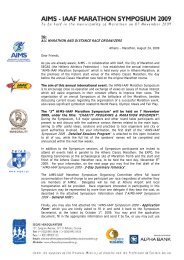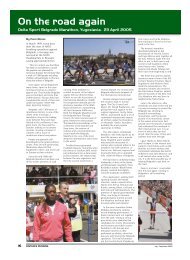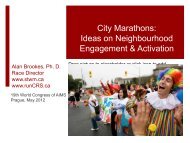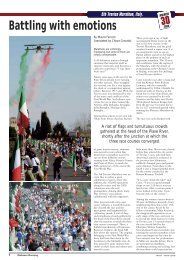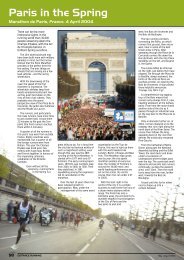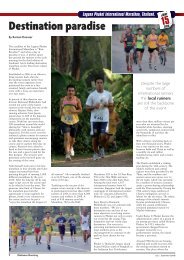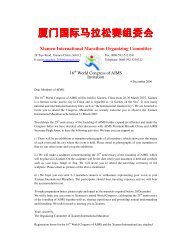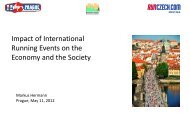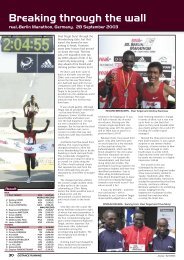Children and Marathoning Final Version 11.02 - AIMS
Children and Marathoning Final Version 11.02 - AIMS
Children and Marathoning Final Version 11.02 - AIMS
Create successful ePaper yourself
Turn your PDF publications into a flip-book with our unique Google optimized e-Paper software.
The data (enumerated in a 2000 AAP Sports Medicine <strong>and</strong> Fitness Committee statement)<br />
show that children do not adapt to heat stress as well as adults for several reasons.<br />
<strong>Children</strong> have a greater body surface area to body mass ratio than adults (11, 14);<br />
therefore, children gain more radiant heat on a hot day <strong>and</strong> lose more heat to the<br />
surrounding environment on a cool day compared to adults. <strong>Children</strong> also produce more<br />
metabolic heat per unit of body mass, <strong>and</strong> have a lower sweating capacity, resulting in a<br />
decreased ability to dissipate metabolic heat (12, 15, 16). A child takes longer to<br />
acclimatize to heat than the adult (11). <strong>Final</strong>ly, the capacity to convey body heat by<br />
blood from the body core to the skin is reduced in the exercising child. Thus children are<br />
subject to a greater increase in core temperature during endurance activities than are<br />
adults.<br />
Overuse Injuries<br />
Long distance running places high mechanical loads on the skeleton, both from<br />
ground reactive forces associated with gravity <strong>and</strong> muscle contractions. While walking,<br />
an individual is confronted with a ground reactive force equal to one's body weight.<br />
While running, however, these gravitational forces increase to between three <strong>and</strong> six<br />
times body weight, depending on whether one runs on flat surfaces or hilly terrain <strong>and</strong><br />
also on the length of one's stride (especially when going downhill). A runner will l<strong>and</strong> on<br />
each leg between 500 <strong>and</strong> 1000 times per mile, again depending on stride length.<br />
The majority of injuries suffered by marathon runners are overuse injuries (17, 18,<br />
19). It is well established that overuse injuries are of multi-factorial etiology, <strong>and</strong> many<br />
of these common risk factors for overuse injuries exist among both children <strong>and</strong> adults.<br />
5




